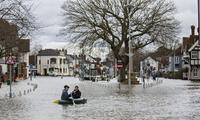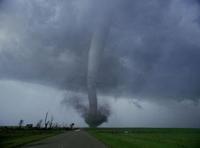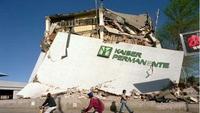-
Microgrids offer cities resiliency, reliability, accessibility
A majority of the world’s population now lives in cities, which consume 75 percent of the world’s resources and emit most of its greenhouse gases. The United Nations estimates that by 2050, an additional three billion people will move into these dense, resource-intense urban environments. The focus in cities like New York or New Orleans is on building infrastructure to make cities more resilient when faced with extreme weather or natural disasters — by providing backup power during outages, as well as helping to ease systems back online as outages end. Microgrid researchers are taking up this challenge by developing an energy solution with the potential to strengthen all three critical factors of energy in a livable city: resiliency, reliability and accessibility.
-
-
Firefighters mull using drones in fighting wildfires
Federal wildland firefighting officials are exploring the deployment of drones to assist in surveillance and reconnaissance missions during a wildfire. Drones sent to survey fire patterns during a wildfire could help keep firefighters out of risky situations by providing real-time information to officials on the ground. Few wildfire officials have used drones in the line of duty, and managers with the U.S. Bureau of Land Management(BLM) and U.S. Forest Servicesay that while the technology has potential, agencies do not have the budget and have not developed protocols to integrate drones into regular firefighting operations.
-
-
States choose different paths to deploying public alert systems
Thanks to systems such as the Federal Emergency Management Agency’s (FEMA) Integrated Public Alert & Warning System (IPAWS), the technology which allows governments to notify residents quickly of an emergency is becoming increasingly cheaper and more effective. Because of this, states are choosing different and unique paths toward deploying such systems within their infrastructure. States are choosing between giving local governments the lead on alert systems or providing extensive state-wide oversight.
-
-
Wastewater injection induces Oklahoma quakes: study
The dramatic increase in earthquakes in central Oklahoma since 2009 is likely attributable to subsurface wastewater injection at just a handful of disposal wells, finds a new study. The researchers say Oklahoma earthquakes constitute nearly half of all central and eastern U.S. seismicity from 2008 to 2013, many occurring in areas of high-rate water disposal.
-
-
DHS top priorities: addressing terrorism, cyberthreats, and extreme weather risks
In its second quadrennial review, DHS outlined the department’s efforts to enhance the five homeland security objectives detailed in the first review, issued in 2010. Combating terrorism remains DHS’s primary mission, but recent disasters, including the Deepwater Horizon oil spill in 2010, Hurricane Sandy in 2012, and domestic terrorism events such as the Boston Marathon bombings in 2013, along with cyberthreats against the nation’s infrastructure, have led the agency to adopt a risk-based approach to significant threats from both terrorism and natural disasters.
-
-
U.K. infrastructure facing tough challenges as extreme weather events multiply

The U.K. Institute of Civil Engineering’s (ICE) State of the Nation: Infrastructure 2014 report has highlighted the fact that more frequent extreme weather events will make it increasingly difficult to operate U.K. infrastructure networks in all conditions at the level of service U.K. residents have come to expect, and people’s expectations of availability will need to change. The report grades the U.K.’s Transport, Energy, Flood, Waste, and Water networks from A to E, suggesting more needed to be done if the United Kingdom is to have world class infrastructure.
-
-
U.S. Northwest prepares for the Big One
Seismologists believe the Pacific Northwest is overdue for an earthquake that could register at over 8.0 on the Richter scale, leading many emergency management professionals in the region to anticipate and prepare for the devastating impact such an event would have on the local economy. Experts talk about Triple 3 Resilience Target as a the goal for managing the aftermath of an earthquake: have emergency services running within three days; level of services to sustain the economy within three weeks; and a target of three years to stabilize the economy and prepare for future disasters.
-
-
Tornado threat in Tornado Alley can be eliminated by building walls: scientists

In the United States, most devastating tornadoes occur in Tornado Alley, which is a strip of land between the Appalachian Mountains and the Rocky Mountains, including most American Midwest states. In 2013, there were 811 confirmed tornadoes in the United States, 57 in Europe, and 3 in China. Among 811 tornadoes in the United States, most, especially the most devastating ones, occurred in Tornado Alley. Scientists say that building three 300 meter high and 50 meter wide walls, at the cost of about $160 million each — the first close to the northern boundary of the Tornado Alley, maybe in North Dakota; the second one in the middle, maybe in the middle of Oklahoma and going to east; the third one in the south of Texas and Louisiana – would significantly reduce, if not eliminate altogether, the threat of devastating tornadoes in Tornado Alley.
-
-
Making nuclear power plants more resilient during earthquakes
Researchers in Finland are examining current nuclear power plants’ structure to see where improvements could be made to make them more resilient during earthquakes. Finland currently is building new nuclear power plants, and within ten years, the country expects to be getting 60 percent of its electricity from nuclear plants.
-
-
N.C. “rolling” 30-year sea level rise report gaining support from both sides
In 2010, coastal developers and Republican legislators in North Carolina were alarmed when a state science panel warned that the Atlantic Ocean is expected to increase by thirty-nine inches along the state’s shores by the end of the century. The state legislature soon ordered a four-year moratorium on official sea-level predictions and gave the Coastal Resources Commission(CRC) guidelines for developing a new official state forecast. In May, Frank Gorham III, chairman of the commission, announced that the next forecast will only predict sea-level rise for the next thirty years, a time span during which model-based predictions about sea level rise along the North Carolina coast – about eight inches — are largely accepted by both sides to the climate change debate. Gorham stresses, however, that he wants a “rolling” 30-year forecast to be updated every five years.
-
-
Experts urge deployment of earthquake warning system in California
Scientists say that California has “99.7 percent chance of experiencing a severe earthquake — magnitude 6.7 or higher on the Richter scale — within the next 30 years.” These scientists are urging Congress to consider funding the full-scale deployment of an early-warning earthquake system on the western coast of the United States following successful testing of a prototype and positive results from similar international systems.
-
-
L.A. to catalog buildings at risk of collapse during a major earthquake

After years of efforts to get officials to catalog buildings at risk of collapse during a major earthquake, Los Angeles City Council late last month instructed building officials to establish a database of such buildings. About 29,226 buildings built before 1978 are subject to survey, but city officials would use mapping programs to narrow down which structures need further field inspection. The city estimates roughly 5,800 buildings are at risk, and an additional 11,690 buildings will need inspection on site to determine whether they are soft-story buildings or not. Los Angeles has yet to decide what to do once it compiles the list, and whether to require retrofitting of vulnerable buildings, but seismic experts and policymakers insist that finding out which buildings are vulnerable is a necessary first step.
-
-
Innovative projects seek emergency housing alternative to FEMA’s trailers

Brownsville, Texas may soon become a model for other hurricane-ravaged cities as community groups institute new emergency housing measures in the wake of inexcusable hold-ups on the part of the Federal Emergency Management Agency (FEMA) in providing reconstruction support to the South Texas coast after $1.35 billion in damage from Hurricane Dolly in 2008.
-
-
NIST plans new Centers of Excellence for disaster resilience, forensics
Officials at the National Institute of Standards and Technology (NIST) have announced plans to establish two new research Centers of Excellence to work with academia and industry on issues in forensic science and disaster resilience. NIST plans to hold merit competitions to establish the centers, tentatively planned to be funded at up to $4 million a year for five years.
-
-
Addressing international disaster resilience for U.S., partner countries
While national security efforts seek to prevent terrorist attacks, the United States an partner countries should also prepare to work together to mitigate the effects of a terrorist attack, should such efforts fail. A new report from the National Research Council (NRC) discusses the challenges around the United States and partner countries responding cooperatively.
-
More headlines
The long view
Using Drone Swarms to Fight Forest Fires
Forest fires are becoming increasingly catastrophic across the world, accelerated by climate change. Researchers are using multiple swarms of drones to tackle natural disasters like forest fires.
How Climate Change Will Affect Conflict and U.S. Military Operations
“People talk about climate change as a threat multiplier,” said Karen Sudkamp, an associate director of the Infrastructure, Immigration, and Security Operations Program within the RAND Homeland Security Research Division. “But at what point do we need to start talking about the threat multiplier actually becoming a significant threat all its own?”
